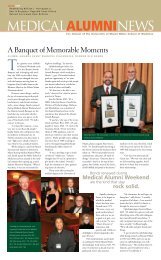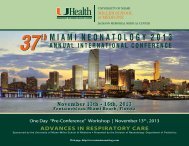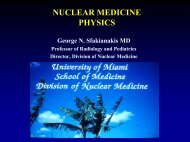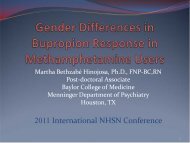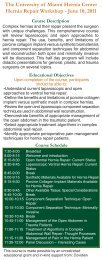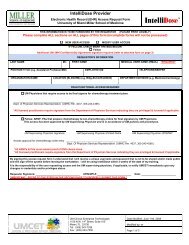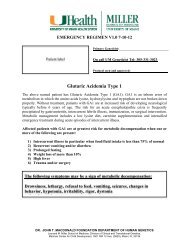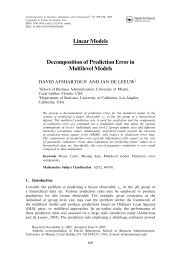Winter 2011 - Neurological Surgery - University of Miami
Winter 2011 - Neurological Surgery - University of Miami
Winter 2011 - Neurological Surgery - University of Miami
- No tags were found...
You also want an ePaper? Increase the reach of your titles
YUMPU automatically turns print PDFs into web optimized ePapers that Google loves.
NeuroFocusWINTER <strong>2011</strong>A physician’s newsletter from the Departments <strong>of</strong> Neurology and <strong>Neurological</strong> <strong>Surgery</strong> at The <strong>University</strong> <strong>of</strong> <strong>Miami</strong>Remarkable Academic Contributionsby our Endovascular GroupBy Roberto C. Heros, M.D., F.A.C.S.We have commented on a couple <strong>of</strong> occasionsin this publication on the groundbreakingclinical advances brought about by our excellentendovascular group. It is remarkable that in spite <strong>of</strong> theextraordinary busy activities <strong>of</strong> this group, they havebeen extremely productive academically. The Director<strong>of</strong> Endovascular Neurosurgery, Dr. Ali Sultan, has leda group <strong>of</strong> our neurosurgical residents and fellows inthe development <strong>of</strong> 18 publications in peer reviewedjournals over the last four years.These publications have described new developmentsin a variety <strong>of</strong> areas such as the treatment <strong>of</strong>retinoblastomas by direct endovascular injection <strong>of</strong>chemotherapeutic agents, an accelerated technique forembolization with Onyx 500, a comparison <strong>of</strong> openversus endovascular carotid sacrifice, the description <strong>of</strong>several unique types <strong>of</strong> endovascular complications andhow to avoid them, the direct percutaneous embolization<strong>of</strong> head and neck tumors to facilitate their surgicalexcision, a safe and effective technique for insertingspinal fluid drainage catheters and rescue <strong>of</strong> ischemicbrain regions by retrieval <strong>of</strong> coil/clot masses.In addition, they have described their experience withthe embolization <strong>of</strong> pediatric tumors and arteriovenousmalformations with Onyx and embolization <strong>of</strong> orbitalhemangiomas in children. They have also developed inthe laboratory percutaneous models <strong>of</strong> embolization inrabbit spleen, a mathematical model <strong>of</strong> coil compaction,embolization in a mouse model <strong>of</strong> retinoblastoma andthe ability to measure venous pressure in a pig model<strong>of</strong> arteriovenous malformation. The residents andfellows that have participated in this remarkably prolificacademic activity include Drs. Stacey Quintero-Wolfe,Samy Elhammady, Roham M<strong>of</strong>takhar, Hamad Farhat,Eric Peterson, Jeremiah Johnson, Ramu Tummala,Asterios Tsimpas, Ramsey R. Ashour and Koji C.Ebersole.Dr. Dileep Yavagal, Director <strong>of</strong> EndovascularNeurology, has also been extremely activein the laboratory and has participated in thedevelopment <strong>of</strong> several clinical studies. Hehas focused his research on novel catheterbasedendovascular therapies for thetreatment <strong>of</strong> acute ischemic stroke includingintra-arterial catheter based endovasculardelivery <strong>of</strong> adult mesenchymal stem cells inrodent and canine stroke models. He is therecipient <strong>of</strong> a competitive interdepartmentalresearch development initiative grant fromthe <strong>University</strong> <strong>of</strong> <strong>Miami</strong> to study the safetyand efficacy on intra-arterial delivery <strong>of</strong> stemcells in a large animal stroke model as wellas in rodents. He and his colleagues wereable to find for the first time the safe maximaltolerated dose <strong>of</strong> intra-arterial stem cellsdelivery. This work was selected for oralpresentation at the 62nd annual meeting <strong>of</strong> theAmerican Academy <strong>of</strong> Neurology this year.Efficacy studies <strong>of</strong> intra-arterial delivery <strong>of</strong>mesenchymal stem cells in large rodents havefound significantly superior outcome in treatedanimals as compared to controls.Dr. Yavagal also leads a single center cohortstudy through UM <strong>of</strong> “Acute Management<strong>of</strong> Ischemic Stroke” to evaluate the impact<strong>of</strong> advanced neuro-imaging to select patientsfor endovascular therapies after an acutestroke. This study has already led to twonational platform presentations. He has alsocompleted a multi-center retrospective study<strong>of</strong> the safety and midterm outcomes <strong>of</strong> simultaneousendovascular therapy to embolize ruptured aneurysmsand treat associated vasospasm. Dr. Yavagal is also theprincipal local investigator for two NIH sponsored andone industry sponsored randomized control trials <strong>of</strong>Jeremiah Johnson, M.D., resident (left), Samy A. Elhammady,M.D., chief resident, M. Ali Aziz-Sultan, M.D., AssistantPr<strong>of</strong>essor <strong>of</strong> <strong>Neurological</strong> <strong>Surgery</strong>, Koji C. Ebersole, M.D.,endovascular fellow, and Ramsey R. Ashour, M.D., resident,in the endovascular suite, Jackson Memorial Hospital.Dileep Yavagal, M.D., Director <strong>of</strong> Interventional Neurology(center), and colleague Baowin Lin, M.D., voluntary faculty,examine adult mesenchymal stem cells in the endovascularlaboratory with Steven Amatangelo, M.S., research assistant.endovascular therapy for acute stroke. In the last threeyears, he has published eight peer reviewed articlesand presented 13 abstracts at national and internationalmeetings. •WHAT’S INSIDEPg. 2 - UM Neurology Team Finds Insulin Resistance Association with Stroke Risk,Traumatic Brain Injury Surviving an AK-47,Clinical TrialsPg. 3 - Epilepsy <strong>Surgery</strong> Increasingly Encouraged as a Treatment for Seizure PatientsPg. 4 - In The News,What’s Next,New Multiple Sclerosis Division Director Kottil W. Rammohan, M.D.NeuroFocus is produced by the Departments <strong>of</strong><strong>Neurological</strong> <strong>Surgery</strong> and Neurology at the <strong>University</strong><strong>of</strong> <strong>Miami</strong>’s Miller School <strong>of</strong> Medicine in affiliationwith Jackson Health System.
NEUROLOGYClinical TrialsEthnical/Racial Variations <strong>of</strong> IntracerebralHemorrhage (ERICH)Hemorrhagic stroke occurs in approximately 100,000persons in the U.S. each year, <strong>of</strong> which 40%‐50% die within30 days. Despite comprising less than 20% <strong>of</strong> all strokes,hemorrhagic stroke accounts for 50% <strong>of</strong> the mortalityassociated with stroke and 30% <strong>of</strong> stroke‐related costs.Intracerebral hemorrhage (ICH) accounts for two‐thirds<strong>of</strong> all hemorrhagic strokes. In ICH, half <strong>of</strong> the mortalityoccurs in the first two days after stroke and at present, thereare no proven effective treatments. Decades <strong>of</strong> researchdemonstrate the disproportionate burden <strong>of</strong> ICH amongnon‐Hispanic African Americans and Hispanics, butonly a few hundred cases have been collected with DNAavailable in either minority group. The long‐term goal <strong>of</strong>the Ethnic/Racial Variations <strong>of</strong> Intracerebral Hemorrhage(ERICH) study is to perform a genome‐wide associationstudy (GWAS) to identify genes that affect risk <strong>of</strong> ICHincluding African Americans and Hispanics. This can beachieved by performing a multi‐center case‐control study <strong>of</strong>ICH. All cases and controls will be recruited using identicalinterview processes and phenotype definitions, handling<strong>of</strong> biologic samples, centralized neuroimaging analysis andcase and control identification using identical methods.This methodology would represent a critical advantage toperforming a large genome‐wide association study <strong>of</strong> ICHincluding minorities.PI - Sebastian Koch, M.D.For more information on Neurology clinical trials pleasecall 1-877-977-7724NEUROLOGICAL SURGERYBrain MetastasisUM Neurology Team FindsInsulin Resistance Association with Stroke RiskInsulin resistance appears to be associated with anincreased risk <strong>of</strong> stroke in individuals without diabetes,according to a report by a team <strong>of</strong> Miller School <strong>of</strong>Medicine Neurology researchers published in the Octoberissue <strong>of</strong> Archives <strong>of</strong> Neurology, one <strong>of</strong> the JAMA/Archivesjournals. Their data suggests that insulin resistance is amarker <strong>of</strong> stroke risk independent <strong>of</strong> obesity and othercomponents <strong>of</strong> metabolic syndrome indicating existence<strong>of</strong> alternative pathways, directly related to inflammation,atherosclerosis and stroke risk. The condition contributesto the risk <strong>of</strong> cardiovascular disease, but whether itpredicts ischemic stroke is still a matter <strong>of</strong> debate.Using the homeostasis model assessment (HOMA) toestimate insulin sensitivity, the Miller School team assessedinsulin resistance for 1,509 non-diabetic participants inthe Northern Manhattan Study, a study assessing strokerisk, incidence and prognosis in a multi-ethnic urbancommunity. Participants were followed for an average <strong>of</strong>8.5 years.During the follow-up period, vascular events occurredin 180 participants, including 46 who had fatal or nonfatalischemic strokes, 45 who had fatal or non-fatal heartattacks and 121 who died <strong>of</strong> vascular causes.Individuals in the top one-fourth (quartile) <strong>of</strong> HOMAindex had an increased risk <strong>of</strong> stroke compared to those inthe other three quartiles <strong>of</strong> the HOMA index. Adjustingfor established cardiovascular risk factors—includingglucose level, obesity and metabolic syndrome—did notdiminish the association. The relationship between insulinresistance and the risk <strong>of</strong> first stroke was stronger in menthan women but did not vary by racial or ethnic group.Individuals in the top quarter <strong>of</strong> insulin resistance hada 45 percent greater risk <strong>of</strong> any type <strong>of</strong> vascular event.However, insulin resistance was not associated with heartTraumatic Brain InjurySurviving an AK-47attack or vasculardeath separately.“Thisepidemiologicalstudy shows thatpre-diabetes orinsulin resistanceis very importantamong people withnon-diabetes, as itis clearly associatedwith increased risk<strong>of</strong> stroke,” saidTatjana Rundek,M.D., Ph.D.,associate pr<strong>of</strong>essor<strong>of</strong> neurology andTatjana Rundek, M.D., Ph.D., leadauthor <strong>of</strong> the insulin resistance study.lead author <strong>of</strong> the study. “This knowledge can really helpassess and target people with an increased risk <strong>of</strong> strokeand not yet diabetic. We would need well designed clinicaltrials to determine how to treat these people movingforward, but for now the new knowledge may promptthe physician to treat the risk factors in a patient with prediabetes much more aggressively.”“There are several possible reasons for the stronger effect<strong>of</strong> insulin resistance on the risk <strong>of</strong> ischemic stroke than<strong>of</strong> myocardial infarction in the present study comparedwithin other studies,” the authors write. It may bebecause individuals with a history <strong>of</strong> heart attack wereexcluded from this study or because factors associated withinsulin resistance—including high blood pressure, hightriglyceride levels and low HDL or “good” cholesterollevels—are more significant risk factors for stroke than forheart attack. •Analysis <strong>of</strong> the mechanisms by which systemic cancersmetastasize to the brain. The Department <strong>of</strong> Neurosurgerylaboratory has identified a receptor protein produced bybrain metastases from many different primary cancer types,which is not produced by most cancers that have not yetmetastasized. The ligand (binding protein) for this receptoris also produced by brain metastases. The laboratory iscurrently performing experiments to more carefully analyzethe roles <strong>of</strong> these proteins in brain metastasis. These proteinsmay be targets for future treatments <strong>of</strong> brain metastasis.PI – Ronald J. Benveniste, M.D., Ph.D.Cerebral AneurysmsNeur<strong>of</strong>orm Microdelivery Stent SystemThere is currently no approved method for the treatment<strong>of</strong> wide-necked cerebral aneurysms. The FDA hasdesignated the Neur<strong>of</strong>orm Microdelivery Stent Systemas a Humanitarian Use Device (HUD), the use <strong>of</strong> whichprovides physicians with a tool to treat these difficultaneurysms, that was previously not available. TheNeur<strong>of</strong>orm Microdelivery Stent System is intended foruse with embolic coils for the treatment <strong>of</strong> wide neck,intracranial, saccular aneurysms arising from a parent vesselthat are not amenable to treatment with surgical clipping.Patients are being enrolled for the study through JacksonMemorial Health Systems and the <strong>University</strong> <strong>of</strong> <strong>Miami</strong>.PI – M. Ali Aziz Sultan, M.D. •For more information on <strong>Neurological</strong> <strong>Surgery</strong> Clinicaltrials please call 1-800-996-3783(From left) Daisy Bourges, R.N., M. Ross Bullock, M.D., Ph.D., Clinical Director <strong>of</strong> the Neurotrauma Program, andYasniel Ravelo, fully recovered, in the Jackson Memorial Hospital ICU.Yasniel Ravelo, a 19-year-old <strong>Miami</strong> resident,experienced a severe head trauma when an AK-47bullet entered his head directly below his left eye on theevening <strong>of</strong> October 28, 2008. Survival after a direct hit inthe head, by an AK -47 bullet, is almost unknown, due tothe huge energy, large size, and high velocity, <strong>of</strong> the bullet.Ravelo was target shooting with an AK on hisfamily’s farm in Homestead, Florida, with his brotherand cousin when the incident occurred. A shot was fired,and Ravelo was seen falling directly on to his face, andbleeding heavily, from the wound.Within minutes, Ravelo’s family dialed 9-1-1 andmade their way to the closest major intersection. Ravelorecalls losing consciousness and then experiencing extremenauseousness and vomiting. A trauma unit arrived onthe scene shortly after with an emergency helicopter thatquickly medevaced Ravelo to the Ryder Trauma Centerat Jackson Memorial Hospital (JMH), the only Level 1Trauma Center in south Florida.Ravelo received a sedative from the EMT beforehe was transported to JMH. He recalls being reassured,“Don’t worry, you are just going to go to sleep for while . .
Epilepsy <strong>Surgery</strong> Increasingly EncouragedAs a Treatment for Seizure PatientsDr. Sanjiv Bhatia, Associate Pr<strong>of</strong>essor <strong>of</strong> ClinicalNeurosurgery, strongly feels that medicallyrefractory epilepsy is an imminently surgical disorder andthat all patients who are refractory to medication shouldbe actively investigated to consider their feasibility forsurgical treatment.A recent successful patient case, the treatment<strong>of</strong> Ricardo Ibarra, an adult male who experienced his firstseizure in elementary school, is a testament to the surgery’seffectiveness.Prior to receiving surgery, Mr. Ibarra experiencedsecondary generalized seizures with convulsions. He wastaken to the emergency room multiple times and on oneoccasion experienced 10 sequential seizures requiringintubation and prolonged hospitalization. “While I washospitalized, I woke up and my brother told me that myheart had stopped during one <strong>of</strong> my seizures” notes Mr.Ibarra.Over the years, he has been prescribed a total <strong>of</strong> 8different antiepileptic medications, some in monotherapyand others polytherapy, but no combination had evercontrolled his seizures. At that time he was diagnosed withrefractory epilepsy was referred to the Epilepsy Division atthe Department <strong>of</strong> Neurology at the <strong>University</strong> <strong>of</strong> <strong>Miami</strong>Miller School <strong>of</strong> Medicine.In April 2010, Mr. Ibarra was referred for longtermvideo EEG monitoring at Jackson Memorial Hospitalto determine the area <strong>of</strong> the brain responsible for thegeneration <strong>of</strong> his seizures. During the monitoring he hadmultiple complex partial seizures that were diagnosed to beoriginating from the left temporal lobe.After identifying the onset <strong>of</strong> his seizures, furtherdata was gathered and obtained as part <strong>of</strong> his pre-surgicalevaluation. A dedicated epilepsy protocol brain MRI wasperformed at the <strong>University</strong><strong>of</strong> <strong>Miami</strong>’s Appelbaum’sDiagnostic Imaging Centerthat demonstrated left mesialtemporal sclerosis (MTS).A FDG PET scan showeddecreased glucose metabolismin the left temporal lobewhich correlated anatomicallyto Mr. Ibarra’s EEGspike activity and MRI findings.Mr. Ibarra’s languageand memory function wasevaluated with a Wada testperformed by Dr. EnriqueSerrano. From the results <strong>of</strong>the Wada test, it was determinedthat Mr. Ibarra should be able to undergo surgerywithout developing significant worsening <strong>of</strong> his memory.Mr. Ibarra’s case was then discussed in a comprehensiveepilepsy surgical conference with a team <strong>of</strong>neurosurgeons and epileptologists from the UM Departments<strong>of</strong> Neurology and Neurosurgery. The team agreedthat his best treatment option would be to go ahead withleft anterior temporal lobectomy and amygdalohippocampectomyfollowing intraoperative electrocorticography toassist in the delineation <strong>of</strong> the epileptogenic region. Hewas then scheduled for surgery with Dr. Bhatia at JacksonMemorial Hospital on August 30, 2010.Mr. Ibarra underwent the surgery without anycomplications. Following the surgery, Ricardo has remainedseizure free and has not experienced any worsening<strong>of</strong> his memory. “The surgery gave me back my independence”reports Mr. Ibarra, “I’m now making plans to move(From left) Ricardo Ibarra, Sanjiv Bhatia, M.D., and Enrique Serrano, M.D, discuss the surgery’ssuccess during Mr. Ibarra’s follow up visit.out <strong>of</strong> my parents’ home and finally become more selfsufficient”.Dr. Bhatia has been extremely thrilled at theoutcome.In a follow up visit with his treating epileptologist,Dr. Enrique Serrano, Mr. Ibarra continued to reportno seizures. “Medial temporal lobectomy was definitelya good option for Mr. Ibarra as he had mesial temporalsclerosis resulting in medically refractory epilepsy,” statesDr. Serrano. The option <strong>of</strong> surgical intervention for patientslike Mr. Ibarra gives them a chance towards seizurefreedom or significant reduction <strong>of</strong> medications.In addition to Dr. Bhatia, <strong>University</strong> <strong>of</strong> <strong>Miami</strong>faculty member, Dr. Jonathan R. Jagid, Assistant Pr<strong>of</strong>essor<strong>of</strong> <strong>Neurological</strong> <strong>Surgery</strong>, also performs epilepsy surgerycases in conjunction with Jackson Memorial Hospital. •. ”. Ravelo resumed consciousness 3 surgeries and 21 dayslater.Miraculously, Ravelo was able to obeycommands right from his initial presentation. PreliminaryCT scans, and emergency angiography revealed that theAK bullet had passed under the front part <strong>of</strong> the brain,between the eyes, under the optic nerves, between the twocarotid arteries, and then entered the posterior fossa, viathe petro-clinoid region on the right, then passed throughthe space between the basilar, and middle cerebellararteries, without damaging the vessels, a real miracle(Figures 1, 2).A hematoma developed in the posteriorfossa, on day two necessitating decompression surgeryperformed by Dr. M. Ross Bullock, Clinical Director<strong>of</strong> the Neurotrauma Program and a <strong>Neurological</strong><strong>Surgery</strong> Pr<strong>of</strong>essor, but when the clot was removed, thebullet could not be seen (Figure 3). It had migrated,since he was in the prone position, to lie in the middlecerebellar peduncle. On day five, he developed a massivehemorrhage from the nose and angiography showeda false aneurysm, on the anterior ethmoidal artery,which was emergently embolised using Onyx, by Dr.M. Ali Aziz-Sultan. A second posterior fossa surgerywas conducted by Dr. Bullock to remove the migratingbullet, in part because he developed meningitis, and alsoto prevent further migration, <strong>of</strong> the large ferrous metallicbullet core.Once Ravelo regained consciousness he remainedat JMH for an additional seven days and was cared forby the ICU team, which included Daisy Bourges, R.N.,the nurse primarily responsible for Ravelo’s treatment.Following his discharge from JMH, Ravelo underwentintense rehabilitation at JMH South,which included re-learning how towalk, balance training, etc.The mystery <strong>of</strong> how Ravelosurvived the injury, and how thebullet could have hit him while he wasstanding right next to the weapon, wassolved by an astute police detectivewho searched the dirt pile into whichthey had been firing, and found a thicksteel truck wheel rim, with a freshmetallic gouge, to show that the bullethad hit the rim, and spun 180 degreesround the wheel, to come back hittingRavelo as a ricochet, thus absorbingmost <strong>of</strong> its energy, before hitting thepatient.Today, Ravelo’s left eyewaters occasionally and he no longerhas a sense <strong>of</strong> smell, but apart fromthese minor side effects he is fullyfunctional, and works 8 hour daysrunning his family’s farm.“Dr. Bullock and the ICUteam at Jackson Memorial saved mylife. My family and I are so grateful forthe care I received. I am thankful to bealive,” said Ravelo. •Figure 1. Initial sagittal CTangiogram, showing multiplemetallic fragments from the bulletjacket, and indicating theTrajectory into the posteriorfossa.Figure 2. CT image to showbullet lodged near the surface <strong>of</strong>the Rt cerebellum, after passingthrough the middle cerebellarpeduncle, and between themiddle cerebellar artery, and thebasilar.Figure 3. “Moving Bullet”nowlaying in the middle Cerebellarpeduncle, prior to removal,while the patient was prone.fig. 1fig. 2fig. 3
NeuroFocusThe <strong>University</strong> <strong>of</strong> <strong>Miami</strong>Departments <strong>of</strong> Neurosurgery & Neurology1120 NW 14th Street/Suite 1361-2<strong>Miami</strong>, Florida 33136Neurology: 305-243-6732neurology.med.miami.edu<strong>Neurological</strong> <strong>Surgery</strong>: 305-243-6946neurosurgery.med.miami.eduThis newsletter is published by the Departments <strong>of</strong> Neurologyand Neurosurgery at the <strong>University</strong> <strong>of</strong> <strong>Miami</strong>, Miller School<strong>of</strong> Medicine in affiliation with Jackson Health System.Non-Pr<strong>of</strong>it OrgU.S. PostagePAIDPermit No. 438<strong>Miami</strong>, FLRalph L. Sacco, MS, MD, FAAN, FAHA, Chairman <strong>of</strong> NeurologyBarth A. Green, MD, FACS, Chairman <strong>of</strong> <strong>Neurological</strong> <strong>Surgery</strong>Roberto Heros, MD, FACS, Co-Chairman <strong>Neurological</strong> <strong>Surgery</strong>Jacques Morcos, MD, FRCS, Medical EditorJessica Busquets, Department <strong>of</strong> Neurology WriterKasey Hayes, Department <strong>of</strong> <strong>Neurological</strong> <strong>Surgery</strong> WriterRoberto Suazo, Graphics Design and Layout© <strong>2011</strong> <strong>University</strong> <strong>of</strong> <strong>Miami</strong>, Miller School <strong>of</strong> Medicine. All Rights ReservedIn The News<strong>University</strong> <strong>of</strong> <strong>Miami</strong> to Host the 2012 AANS Scientific MeetingApril 14-18, 2012<strong>Miami</strong>, Florida<strong>Miami</strong> was named the location <strong>of</strong> the 2012 AANS Scientific Meeting. The fourday symposium, which draws expertise from medical and scientific communities,is especially designed for neurological surgeons. The <strong>2011</strong> Scientific Program willinclude practical clinics, breakfast seminars, oral paper presentations and electronicposter presentations.www.aans.orgUM Brain Bank Receives NIH Award for Genotype-TissueExpression ProjectThe <strong>University</strong> <strong>of</strong> <strong>Miami</strong>/National Parkinson’s Foundation Brain Endowment Bank,directed by Deborah Mash, Ph.D., the Jeanne C. Levey Pr<strong>of</strong>essor <strong>of</strong> Neurology andMolecular and Cellular Pharmacology, is the recipient <strong>of</strong> a three-year award fromthe NIH to partner with researchers across the country for the Genotype-TissueExpression project (GTEx). A two-year, $25 million pilot project supported by theNIH Common Fund, GTEx is designed to generate data for the systematic study <strong>of</strong>how gene expression is regulated in different organs in the human body, a key stepto explaining the underlying biology <strong>of</strong> many organ-specific diseases, such as heartdisease or mental illness.http://commonfund.nih.gov/GTEx/What’s NextNew Multiple Sclerosis Division DirectorKottil W. Rammohan, M.D.Kottil W. Rammohan, M.D., recently joined the department <strong>of</strong> neurology as Pr<strong>of</strong>essor and Director <strong>of</strong>the Multiple Sclerosis Center at the <strong>University</strong> <strong>of</strong> <strong>Miami</strong>. He is board certified by the American Board <strong>of</strong> InternalMedicine, American Board <strong>of</strong> Psychiatry and Neurology with special competence in Neurology, and The AmericanSociety <strong>of</strong> Neurorehabilitation.Dr. Rammohan previously served as Pr<strong>of</strong>essor and Director <strong>of</strong> Multiple Sclerosis Center at Ohio State<strong>University</strong>. A graduate <strong>of</strong> Madras Medical College in Chennai, India, Dr. Rammohan completed an internship at theCook County Hospital in Chicago, and trained as a resident in Internal Medicine and Neurology at the Ohio State<strong>University</strong>. He was a Fellow and Senior Clinical Associate at the National Institutes <strong>of</strong> Health.A participant in a number <strong>of</strong> investigator and industry initiated clinical trials, Dr. Rammohan’s mainresearch interest is in understanding the pathogenesis and treatment <strong>of</strong> multiple sclerosis (MS). In particular, hehas been involved with understanding mechanisms <strong>of</strong> fatigue, and designing treatments for this disabling symptom.Magnetic resonance imaging, specifically, imaging MS brain abnormalities at Ultra high field strength (8 tesla). Hiscontributions include developing novel and simple techniques for examination <strong>of</strong> abnormalities in the cerebrospinalfluid in MS. At a basic level, his interests include exploring autoimmunity to ion channels in MS and exploringmechanisms <strong>of</strong> action <strong>of</strong> the presently used disease modifying therapies in multiple sclerosis.Integrally involved in the study <strong>of</strong> MS, Dr. Rammohan has served the National Multiple Sclerosis Society asa member <strong>of</strong> both the Medical Advisory Board and the Clinical Care Committee. He chaired the Clinical AdvisoryCommittee at the National level.Eleventh Annual Hubert L. Rosom<strong>of</strong>f Research DaySaturday, March 26, <strong>2011</strong>The Department <strong>of</strong> <strong>Neurological</strong> <strong>Surgery</strong> will host the eleventh Hubert L. Rosom<strong>of</strong>fResearch Day on Saturday, March 26, <strong>2011</strong> from 8:30 a.m. to 1:00 p.m. in the Lois PopeLIFE Center, seventh-floor auditorium. The event will showcase research by neurologicalsurgery residents, fellows and faculty. The visiting pr<strong>of</strong>essor will be Edward R. Laws, Jr.,M.D., F.A.C.S. Director, Pituitary/Neuro-endocrine Center, Brigham & Women’s HospitalHarvard <strong>University</strong>.For further information, call 305-243-6751.Neurology Update and Stroke Intensive <strong>2011</strong>February 24-26, <strong>2011</strong>The Alexander Hotel, <strong>Miami</strong> Beach, FLNeurology Update and Stroke Intensive <strong>2011</strong> is designed to provide clinicians with the mostrecent developments in the diagnosis and management <strong>of</strong> neurologic disorders, includingstroke. The stroke seminar on Saturday is a stand-alone 8-hour CME activity that willprovide the annual CME credits needed for stroke team personnel. For those planning toreceive stroke center status, this course will provide stroke teams with the most up-to-dateevidence in the field. This activity has been approved for AMA PRA Category 1 Credit.www.cme.med.miami.edu




